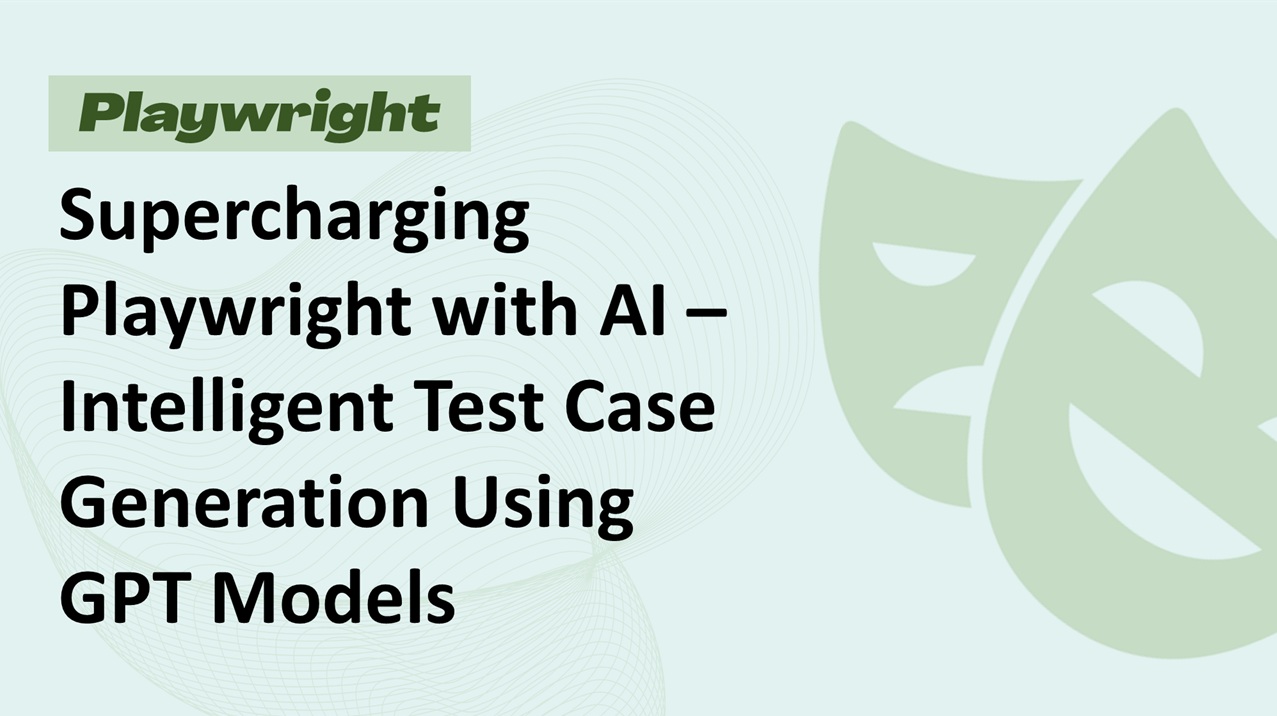Modern applications are evolving fast, and so should our testing. Manual test case writing can't keep pace with complex UIs, rapid development, and ever-increasing test coverage demands. This is where AI-powered test generation shines.
In this article, you'll discover how to leverage GPT models to generate Playwright tests automatically from user stories, mockups, and API specs—cutting test creation time by up to 80% and boosting consistency.
🚀 The AI Testing Revolution – Why Now?
Web applications today have:
- Dynamic UIs
- Complex workflows
- Rapid iteration cycles
Manual testing falls short due to:
- ⏳ Time-consuming scripting
- 🎯 Inconsistent test quality
- 🛠 High maintenance overhead
- 📉 Skill gaps in Playwright expertise
IMPORTANT: AI-generated tests solve these issues by converting high-level specifications into consistent, executable scripts—within minutes.
🔍 Core Use Cases
1. 🧾 User Story → Test Script
User Story: “As a customer, I want to add items to my shopping cart, modify quantities, and checkout.”
An LLM can auto-generate Playwright tests for:
- Item addition/removal
- Quantity updates
- Cart persistence
- Checkout validation
2. 🧩 UI Mockups → UI Tests
From screenshots or Figma mockups, AI identifies UI components and generates:
- Field validation tests
- Button click paths
- Navigation workflows
3. 📡 API Docs → Integration Tests
Given OpenAPI specs or Swagger files, AI generates:
- API response validators
- Auth flow tests
- Data transformation checks
4. 🔁 Regression Suite Generation
Scan your codebase and let AI generate:
- Tests for business-critical paths
- Version-aware regression scenarios
- Cross-browser validations
✍️ Prompt Engineering: The Secret Sauce
High-quality output requires high-quality prompts.
TIP: Craft prompts like you're onboarding a new teammate. Be specific, structured, and clear.
🧠 Tips for Better Prompts
- Context-Rich: Include business logic, user persona, architecture info.
- Structured Templates: Use consistent input formats.
- Code Specs: Tell the AI about your conventions, selectors, assertions.
🛠️ How AI Builds Playwright Tests
The test generation pipeline includes:
- Requirement parsing
- Scenario/edge case detection
- Selector/locator inference
- Assertion strategy
- Setup/teardown
TIP: AI-generated tests often contain proper waits, good selectors, and meaningful error handling out of the box.
🔬 Examples by Domain
🛒 E-commerce Cart
- Add/remove items
- Update quantity
- Validate prices
- Empty cart flows
📋 Form Validation
- Required field checks
- Format enforcement
- Success + error paths
- Accessibility & UX feedback
🔄 API Integration
- GET/POST/PUT/DELETE tests
- 401/403/500 handlers
- JSON schema validation
- Token expiration
⚖️ AI vs. Manual Tests
| Metric | AI-Generated | Manual |
|---|---|---|
| Creation Time | ⚡ ~85% faster | 🐢 Slower |
| Initial Coverage | 📈 ~40% higher | 👨💻 Depends on tester |
| Bug Detection | 🐞 ~15% higher | 🧠 Domain-aware |
| Maintenance | 🧹 +20% overhead | 🔧 Controlled |
| False Positives | 🔄 ~25% higher | ✅ Lower |
| Business Logic | 🧠 ~10% less accurate | 🎯 High fidelity |
IMPORTANT: Use AI for breadth, and humans for depth. Combine both for maximum coverage.
🧠 Advanced Prompt Engineering
🧪 Multi-Shot Prompting
Provide several examples for the AI to follow.
🧵 Chain-of-Thought Prompting
Ask AI to reason before generating.
🔁 Iterative Refinement
Start, review, improve. Repeat.
🎭 Role-Based Prompting
“Act like a senior QA” gets better results than generic prompts.
🧩 Integrating AI into Your CI/CD Workflow
Phase 1: Foundation
- Define test structure
- Create reusable prompt templates
- Set up review pipelines
Phase 2: Pilot
- Begin with UI flows, login, cart, or forms
- Involve human reviewers
Phase 3: Scale
- Add coverage for APIs, edge cases
- Train team on prompt best practices
🛡️ Maintaining AI-Generated Tests
Use tagging to distinguish AI-generated files.
Review regularly for:
- Fragile selectors
- Obsolete flows
- Over-tested paths
TIP: Use GitHub Actions to auto-regenerate stale tests weekly.
📈 KPIs to Track
| KPI | Purpose |
|---|---|
| Test Creation Time | Velocity |
| Bug Catch Rate | Quality |
| Maintenance Time | Overhead |
| False Positives | Trust |
| Coverage Gained | ROI |
🔮 Future Trends
- 🖼️ Visual test generation from screenshots
- 🗣️ Natural language test execution (e.g., “Test checkout flow”)
- 🔁 Adaptive test regeneration on UI changes
- 🔍 Predictive test flakiness detection
✅ Final Thoughts
AI doesn’t replace your QA team—it supercharges them.
By combining:
- GPT-based prompt generation
- Human review and refinement
- CI/CD integration
You can reduce time-to-test by weeks while increasing test quality.
CTA: Try our GitHub starter kit and let AI handle the boring test boilerplate while your team focuses on real innovation.
The future of testing isn’t just faster—it’s intelligent.

